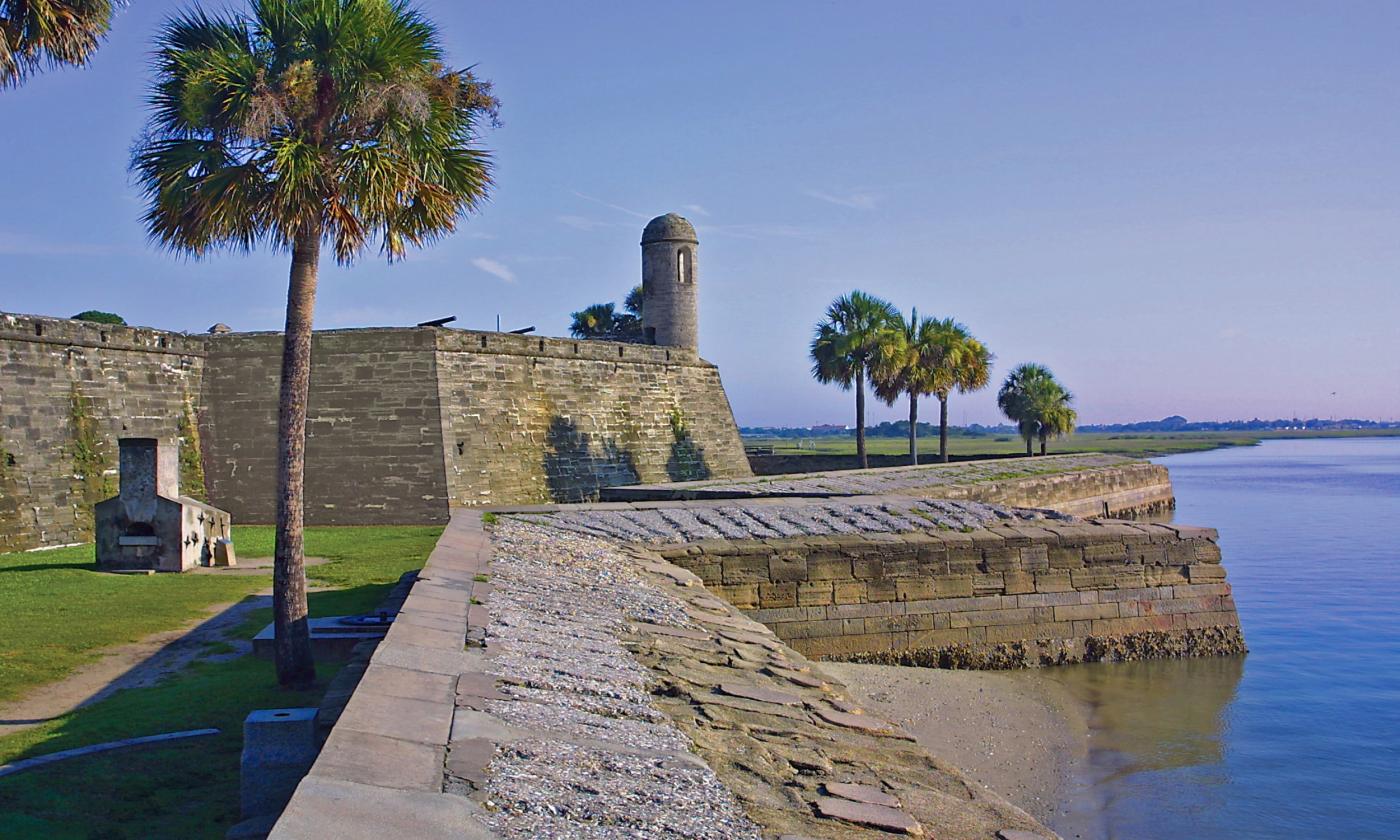Castillo de San Marcos
Castillo de San Marcos
Quick Lesson: What is Coquina?
The Castillo de San Marcos is infamous for its ancient grey appearance. But what did the Spanish use to build it here in marshy Florida? They used coquina.
Coquina is a unique stone that is native to Florida's northeast coast. It is mined from the ground, where thousands of years of pressure have pressed tiny shells into a soft stone that could be cut from the ground with a hatchet. Coquina became a very important resource in St. Augustine and it was used to build many of the colonial homes that still stand today. When the Castillo was first attacked in 1702, the Spaniards discovered that the coquina stone did not break under cannon fire, instead absorbing artillery into its porous surface.
The Castillo's Diverse Construction Crew
After generations of fires, pirate raids, and weather damaging St. Augustine's first fortifications (all made of wood), it was Governor Manuel de Cendoya (1671-1673) who oversaw the stone fort's groundbreaking.
Over a period of over 20 years, African, European, and Indigenous men built the Castillo. Some were free, some were enslaved (whether by private citizens or the city itself), and some were convicts. Some men contributed manual labor in the coquina mines on Anastasia Island, while others contributed skilled labor like blacksmithing.
Black Militias in the First Spanish Period
During the First Spanish Period (1565-1763), Florida was chronically under-funded, under-staffed, and under-protected. So, out of necessity, free and enslaved Africans were a part of St. Augustine's construction and defense from the very start.
After it was completed, the Castillo became the center of command for St. Augustine's Spanish military, which included militias of Black soldiers as early as 1683. In the late 1600s and early 1700s, these men participated in military maneuvers throughout the southeast region, sometimes collaborating with militias from other Spanish colonies, such as Louisiana and Cuba.
Changing Flags
St. Augustine has also been called the "City Under Five Flags." All of those flags were raised at the Castillo de San Marcos, the center of command for the city's many military installments. The flags of Spain, Great Britain, the Confederate States of America, and the United States of America have flown over this fort. These nations also changed the name of the Castillo, which was called "Fort St. Mark" by the British and "Fort Marion" by the early Americans (after Revolutionary War general Francis Marion).
The history of St. Augustine is often divided into a series of eras: Pre-Colonial Era (before 1565), the First Spanish Period (1565-1763), the British Period (1763-1783), the Second Spanish Period (1783-1821), the American Territorial Period (1821-1845), and the American Statehood Period (1845-Present Day).
As power changed hands between these nations, reality changed for the Black people in St. Augustine. While they were considered souls by the Spanish (though still looked down on for their race), the British granted African people no rights. It was similar in the United States of America, which had absorbed their chattel system of slavery from their British predecessors.
Fort Marion & The Civil War
Florida seceded from the Union on January 10th, 1861, with much celebration from St. Augustine's White residents. Confederate troops occupied the fort until February 25th, 1862, when they were ordered to abandon St. Augustine. The Union Army took the fort three days later, on February 28th, as a part of a widespread invasion of southern coastal cities.
For the rest of the Civil War (1861-1865), the Union Army controlled the city of St. Augustine. Some of St. Augustine's citizens supported this change, while others (many of them women) began protesting Union occupation. Enslaved Black people also began to come to the Castillo to make pleas for their freedom.
On January 1st 1863, President Abraham Lincoln's Emancipation Proclamation freed all enslaved people in Union territories. Because St. Augustine was controlled by the US Army, the enslaved people in town were included in this measure. According to the Florida State Archives, about 672 Black St. Augustinians were granted their freedom that day.
In the generations that followed, the rights of African Americans were strategically limited by the state and federal governments during an era called Jim Crow.
American Military Outpost and Tourist Attraction
Federal troops were present in St. Augustine until 1900. Even while the military was still active here, the ancient-looking fort became a central destination for St. Augustine's visitors. Ownership of Fort Marion was transferred to the newly formed National Park Service around 1935.
The St. Augustine Civil Rights Movement
During the American Civil Rights Movement, which reached a height of activity in the 1960s, the lawn of the Castillo became a site of peaceful demonstrations. People who protested segregation would often gather under a red cedar called the "Freedom Tree," singing praise songs and holding talks.
The Castillo (along with all other federal property) was integrated with the passing of the 1964 Civil Rights Act.
Visiting the Castillo de San Marcos National Monument
The Castillo de San Marcos National Monument was added to the National Underground Railroad Network to Freedom in 2020. The National Park Service welcomes visitors and locals into the Castillo seven days a week.
The fort is under consistent efforts of preservation, and exhibits can be found in most of the rooms. Park Rangers and volunteers provide interpretive programs throughout the year, including cannon firings on the weekends.
Resources
Online Resources
From the Castillo de San Marcos website:
(click the links to read)
- African Americans in St. Augustine (1565-1821)
- African Americans in St. Augustine (1821-Present)
- The Founding of the Castillo de San Marcos
- The Civil War in Florida
- Where Did They Come From?: The Global Origins of St. Augustine Residents
Or, for the Castillo’s Kids & Youth Resources, tap here.
Further Reading
The Building of the Castillo de San Marcos, by Luis Rafael Arana and Albert Manucy


